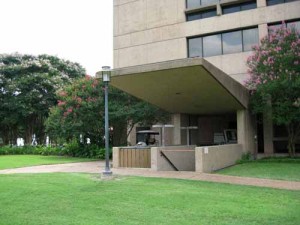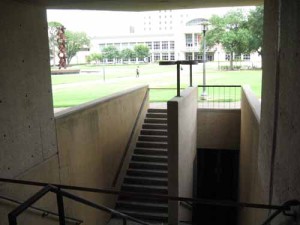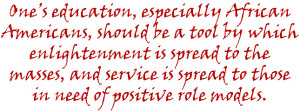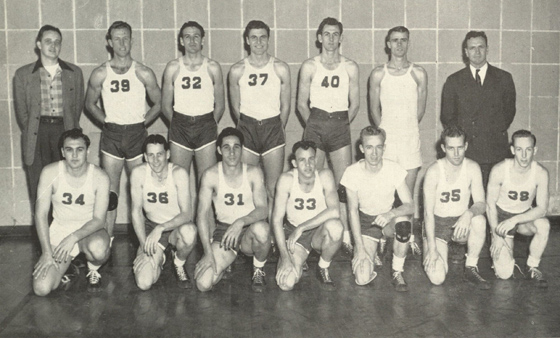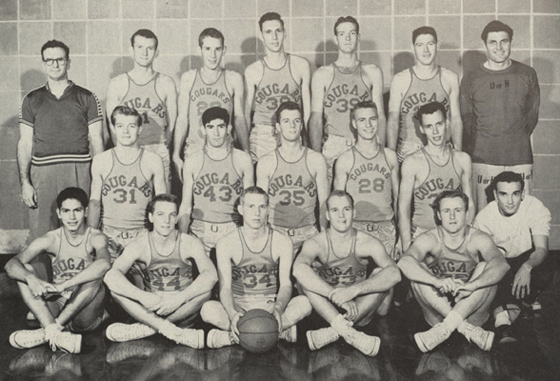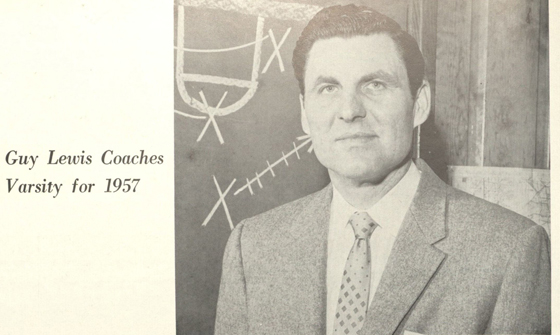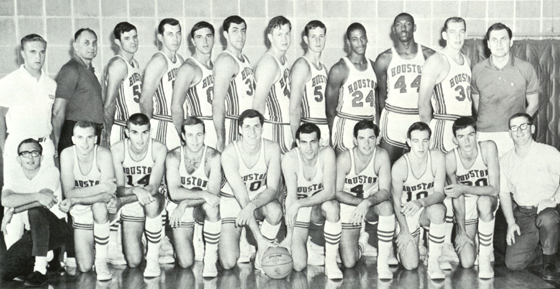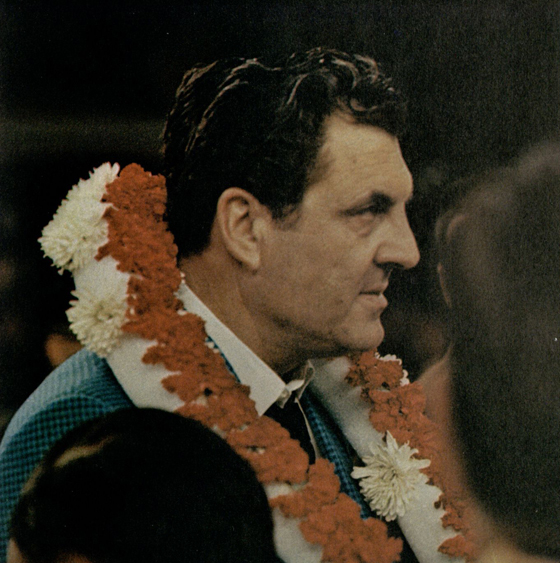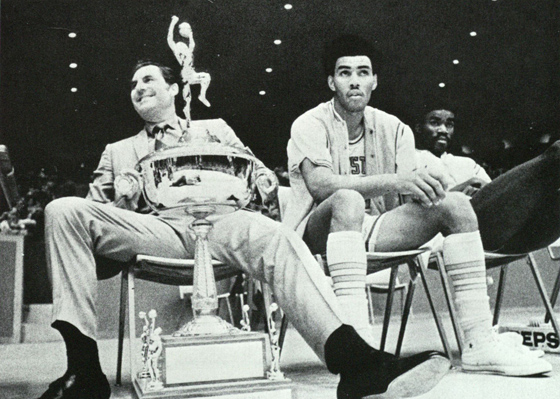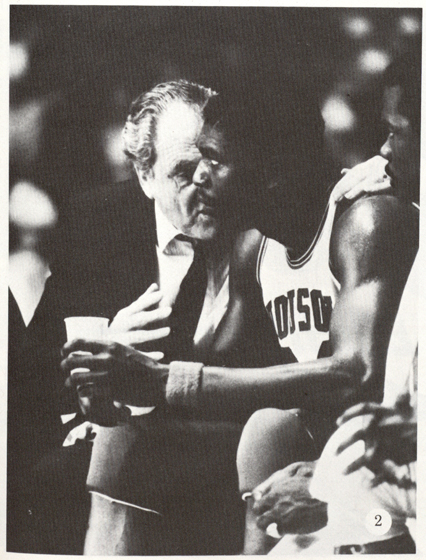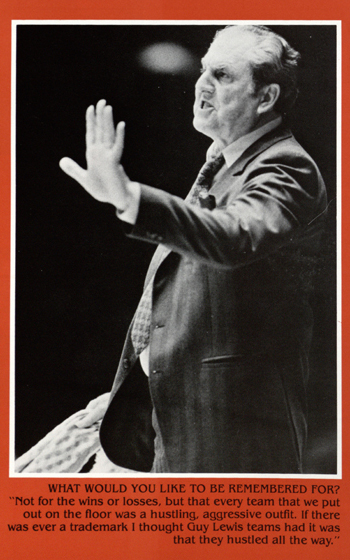
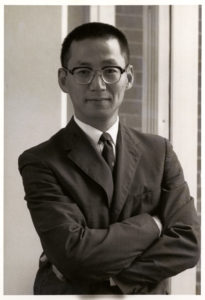
Professor Jay K. Kochi (1962, Professor Jay K. Kochi Papers)
The University of Houston Special Collections and University Archives are proud to announce the publication of the finding aid for the Professor Jay K. Kochi Papers.
Known as a leader in the field of organic chemistry, Dr. Jay Kazuo Kochi (1927-2008) was born May 17, 1927 in Los Angeles, California. As WWII raged, Kochi’s family was relocated to an internment camp in Arizona when he was 15. Kochi would graduate high school in the camp before studying at UCLA (Bachelor of Science, 1949) and Iowa State (Doctorate, 1952). He worked as an instructor at Harvard (1952-55) and completed a fellowship at Cambridge (1955-56) before going to work as a research scientist in exploratory chemistry for Shell Development Co. (1956-1962). Kochi would later return to academia, holding positions at Case Institute of Technology (or Case Western Reserve), Indiana University, and finally arriving at the University of Houston in 1984.
Best known for developing a one-carbon oxidative degradation of carboxylic acids known as the Kochi Reaction, his career is marked by accolades and recognition. A member of National Academy of Sciences, Professor Kochi was also a recipient of the Alexander Von Humbolt U.S. Senior Scientist Award, the American Chemical Society’s Arthur C. Cope Scholar Award, and the James Flack Norris Award. Inquisitive to the end, Kochi’s continued to contribute his research findings in the field of organic chemistry until his death in 2008 at the age of 81.
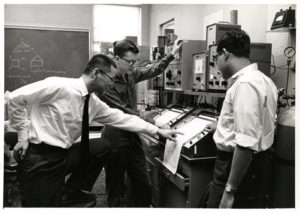
Prof. Kochi and others at work in the lab (undated, Professor Jay K. Kochi Papers)
The University of Houston Special Collections is honored to offer a home for Dr. Kochi’s papers. As a part of our larger University Archives, the Professor Jay K. Kochi Papers will stand beside the collections of other professors and luminaries who have helped define and guide the University. Spanning over 120 linear feet, the collection includes research, correspondence, photographs, and publications penned by Kochi. Those interested in learning more about the life and career of Dr. Kochi should visit our new finding aid for a detailed inventory of the materials included in the collection. When you are ready to visit, we look forward to assisting you with your research.
Have you noticed the stairs to nowhere? Hiding in plain sight, in the center of the University of Houston campus, next to Philip G. Hoffman Hall, a concrete canopy protects the entrance to what looks like a Cold War bomb shelter. Now abandoned and gathering debris, this is a relic of the university’s soured love affair with underground buildings.
In the 1960s, the campus assumed a more suburban look; new buildings were widely-spaced, separated by expansive lawns and groves of trees. To preserve this park-like setting, university planners tried to hide new buildings beneath lawns or plazas. It was all very logical: A plot of land did double-duty, allowing the university to capture usable space for activities without losing precious open space outdoors.
During this period four buildings and parts of others were placed underground, but by 1980 this fad had run its course. What happened? Public tastes changed as Modern architecture, which brought us the underground buildings, lost favor to more traditional styles. More importantly, university planners recognized the dangers of flooding in low-lying Houston. Flooded streets have always been a nuisance, but flooding from Tropical Storm Allison in 2001 was unprecedented and caused millions of dollars in damage to campus buildings. Today the university does not put buildings underground, and new buildings do not have basements.
But in case you missed them, here are the present and former structures beneath our feet:
University Computing Center (early 1960s)
Buried a few yards north of the Ezekiel Cullen building is a facility that began life in the 1960s as the University Computing Center. When the university moved its mainframe computers to a new building on Elgin Street in 1976, this area became an office annex for E. Cullen. Allison filled it with water. Rather than repair the damage, the university locked the doors and abandoned it.
University Center Annex (1965)
In the mid-1960s the university spent a lot of money to dig a huge hole next to the University Center for an underground annex topped by a plaza. Fifty years later, as part of the UC renovations, the university spent a lot of money to fill in the hole and build the replacement structure on top of it. It has no basement level.
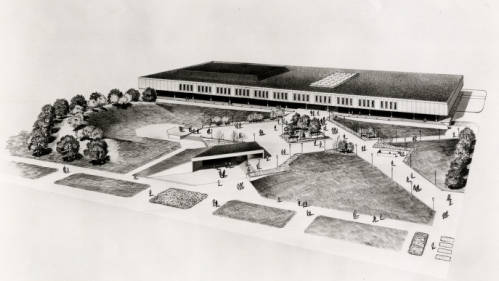
Architectural rendering of University Center with underground annex in foreground, mid 1960s. Photo courtesy of UH Buildings Collection, Digital Library.
Agnes Arnold Hall (1968)
From the south, Agnes Arnold Hall, a mid-rise tower, appears to rise from a large open courtyard located below street level. The building is reached by a bridge, which spans the courtyard below. In Allison the courtyard, a basement-level lecture hall, as well as elevators and escalators, were all flooded.
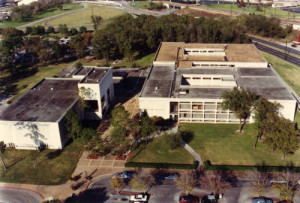
UH Law Center. Large plaza in background covers underground library. Central courtyards in classroom buildings on right also cover underground libraries. Photo courtesy UH Buildings Collection, Digital Library.
Law Center (1970)
The UH Law Center opened in the early 1970s with a group of two-story classroom buildings clustered around a large plaza. Beneath the plaza was the law library. Each of the classroom buildings had an atrium-courtyard; below it was a satellite library in the basement. In Allison the entire lower level flooded, causing catastrophic damage to the library collections.
University Center Satellite (1973)
As the campus expanded to the northwest, university planners grouped the new science and fine arts buildings around a grassy quadrangle. Beneath this lawn was the new University Center Satellite, which provided dining and recreational facilities for students on this end of the campus. This building was inundated in Allison and remained closed for repairs for more than a year.
Hilton Hotel Parking Garage (early 1970s)
When the University Hilton and the adjoining School of Hotel and Restaurant Management were built in the 1970s, the complex included a parking garage. The garage is under the building, reached by a steep ramp from the street. Like all of the other underground structures, it flooded in Allison.
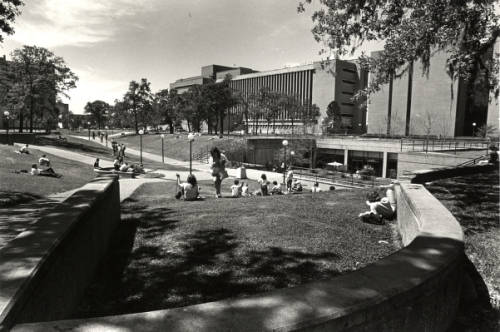
Students lounge outside UC Satellite, circa 1980. Sloped lawn directs water toward entrance. Photo courtesy UH Buildings Collection, Digital Library.
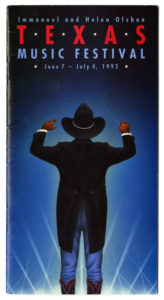
Program from the Immanuel and Helen Olshan Texas Music Festival Records, 1992
Each summer the Immanuel & Helen Olshan Texas Music Festival provides an opportunity for talented young musicians to come together and learn from professional musicians as well as faculty from the Moores School of Music. This year’s festival performances kicked off June 11 and run through July 2.
In 2013, the University Archives acquired records documenting the history of this distinctive program. The recently processed Immanuel and Helen Olshan Texas Music Festival Records contain concert programs, publicity and press materials, a scrapbook, as well as concert recordings covering the history of the festival from 1985 to 2013.
In addition to documenting a vital part of the city and the University’s musical landscape, the Immanuel & Helen Olshan Texas Music Records also exemplify the changing nature of the archival record, and the challenges repositories face along with it. While the paper portion of the TMF records is comparatively small, the records also include over 200 digital recordings. These recordings arrived on CDs, an unstable media not suitable for long-term archival storage. The TMF records arrived just as the department was beginning to explore in earnest methods for accessioning born digital materials and transferring files to secure digital archival storage. As Special Collections has continued to acquire collections containing a variety of digital media formats, we continue to improve our processes for preserving, describing, and providing access to these materials.
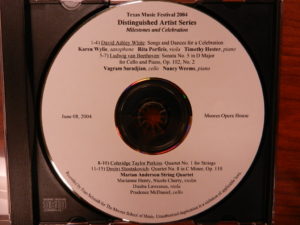
Texas Music Festival Distinguished Artist Series Milestones and Celebration concert recording, June 8, 2004
For now, the digital concert recordings are minimally described in the finding aid with an overview of what is available, including the date range of recordings. Researchers, performers, or fans wanting to get more detail on the recordings—including dates, soloists and conductors, and pieces played for specific concerts—are encouraged to contact University Archivist Mary Manning with inquiries. With advance request, the concert recordings can be made available for listening on a computer in our reading room.
As they record a dynamic cultural and educational event, it is only appropriate that the Immanuel and Helen Olshan Texas Music Festival Records also help orchestrate a transition in the archives to a new era in collecting, preserving, and making accessible our cultural heritage.
This spring 2016 semester we are proud to partner once again with the English Department’s Professional Internship Program and host Elizabeth Beaver, our newest UH Special Collections Social Media Intern. As part of her duties, Beaver will be researching, drafting, and editing content for the Special Collections blog as well as our Facebook page. In her first contribution, she examines the founding and evolution of African American Studies at the University of Houston.
1969: The Dawn of a Trailblazing Academic Program
Elizabeth Beaver
Today, I would like to pay homage to our very own African American Studies Department which has its roots in the civil rights movement of the 1960s.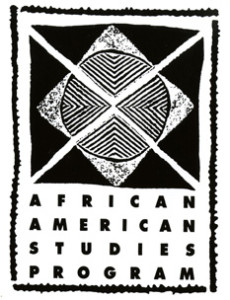
The 1960s were a time of intense civil rights activism which generated a great deal of momentum for issues of racial equality. In comparison to the national ferocity, the citizens of Houston presented a more subdued and subtle front. A city-wide media blackout and backroom negotiations allowed the city to quietly take on the task of integrating its large, commercial establishments without the horrific scenes of violent clashes taking place in other Southern cities. Despite this compromised and negotiated “peace” of the period, University of Houston students’ demands for changes in the curriculum found them standing at the fore of the evolution of Liberal Arts education in the South. In 1969, dissatisfied with the status quo, the student organization Afro-Americans for Black Liberation (or AABL) presented University President Philip Hoffman with a list of ten demands. The 1969 Houstonian reports that the so-called demands included “more black administrators and instructors,” “a raise in the pay scales for maintenance employees,” as well as the establishment of “an Afro-American studies department.” The University rose to the demands of the students, as well as the changing social climate of the city itself, and launched a number of African American Studies courses in the spring of 1969.
Exploring a new field of study, the African American Studies Program actively invited interest and education in an important cultural field that had previously been entirely sidelined. In an era rich with advocacy and public protest, the University of Houston was quick on the heels of the first program in the nation (offered by San Francisco State University in 1968), and was the first in Texas and the Southeastern United States to offer one of these trailblazing programs.
The value of education may be a given. However, the establishment of the African American Studies Program illustrated this importance in two ways: 1) It provided expanded educational opportunities to individuals (of all colors and creeds) in a field of study that had reached a critical mass of interest and demand and 2) exemplified that education served a larger, societal impact, given the previous marginalization of scholarship related to the African American experience.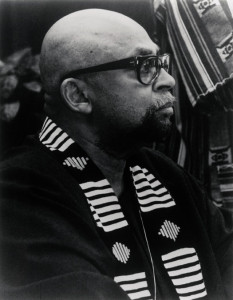
Over the years, the AAS Program has hosted many notable speakers, including highly acclaimed scholar and writer Dr. Maulana Karenga, astronaut and former UH Graduate Bernard A. Harris, and many other distinguished leaders. Our archives contain records from when Dr. Karenga came to speak in February of 1995, and include travel details and information related to the talk and panel, “Black Studies, Social Policy and Social Practice: Joining Campus and Community.” As a prominent scholar in his field, astronaut, and UH graduate, Bernard Harris was invited to the university by the AAS Program to give a talk in January of 1994. Only a year later he was a member of NASA’s STS-63 Crew and became the first African American to take part in Extravehicular Activity or “EVA” (NASA nomenclature for a spacewalk)! The organization plans and details for his campus talk can be found in our African American Studies Records. The folder contains, among other things, personal details and biographical information, education and honors received, as well as mission highlights from the time he logged in space. We also have a video interview of Harris (available digitally, as well) if you are interested in learning more about this esteemed astronaut and UH alum.
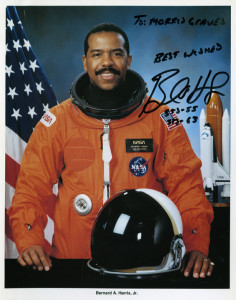 The current African American Studies Department is the result of significant growth over numerous decades and the recent efforts by university authorities. In March of 2014, CLASS Dean John W. Roberts appointed a task force dedicated to the growth and development of the AAS Program. By the next year, it was a fully formed department making plans for African American History Month. The current department has big plans for this year as well, now boasting a wide selection of courses and opportunities for community outreach. The department enjoys a longstanding study abroad relationship with Gambia, as well as numerous scholarship offerings. The department has grown to match the needs of the University and the city as they develop and change, and it continues to impact Houston’s diverse cultural environment in increasingly positive ways. The program organizes many different off and on-campus talks and events as well as community involvement opportunities, and has hosted numerous visiting scholars over the years.
The current African American Studies Department is the result of significant growth over numerous decades and the recent efforts by university authorities. In March of 2014, CLASS Dean John W. Roberts appointed a task force dedicated to the growth and development of the AAS Program. By the next year, it was a fully formed department making plans for African American History Month. The current department has big plans for this year as well, now boasting a wide selection of courses and opportunities for community outreach. The department enjoys a longstanding study abroad relationship with Gambia, as well as numerous scholarship offerings. The department has grown to match the needs of the University and the city as they develop and change, and it continues to impact Houston’s diverse cultural environment in increasingly positive ways. The program organizes many different off and on-campus talks and events as well as community involvement opportunities, and has hosted numerous visiting scholars over the years.
We invite you to come by the reading room to catch a few exciting glimpses into the history of this exemplary academic program via the the University Archives and the African American Studies Records!
University of Houston basketball legend Guy Vernon Lewis II was laid to rest today. Lewis passed away on Thanksgiving, November 26, 2015, in Kyle, TX at the age of 93. To say Houston Cougar basketball is indebted to Coach Lewis is to tiptoe around a libelous understatement. From when he first laced up his sneakers for the Red and White in 1946, through his retirement from coaching in 1986, and into his enduring presence and counsel in his later years, Cougar basketball, athletics, and the University itself were forever changed by his decades of service and devotion. Inducted into the Basketball Hall of Fame in 2013, Lewis saw his teams lay claim to two Southwest Conference championships, four SWC tournament championships, five Final Four appearances, and tally 592 wins under his tenure as head coach of the Cougars.
A snapshot history of Guy V. Lewis and the University of Houston
- 1946: Fresh from his service in World War II, Lewis (#37) begins his playing career with the 1946 Lone Star Conference champion Houston Cougar basketball team. (Houstonian)
- 1953: Lewis (back row, far right) joins the Cougars as an assistant coach. (Houstonian, 1954)
- 1956: Coach Alden Pasche announces his retirement and the University of Houston names Guy V. Lewis as the program’s new head coach. He would serve in that role for the next thirty years. (Houstonian, 1957)
- 1966: While Warren McVea was turning heads for Coach Bill Yeoman’s gridiron Coogs, Lewis (back row, far right) recruits Don Chaney (#24) and Elvin Hayes (#44) were integrating Houston Cougar basketball (Houstonian). For more on UH and Lewis’s role in integrating intercollegiate athletics in the South, see the new book from Robert Jacobus, Houston Cougars in the 1960s: Death Threats, the Veer Offense, and the Game of the Century.
- 1968: Coach Lewis victorious following the Game of the Century (Houstonian). In front of more than 52,000 fans in the Astrodome and millions more on national television (a first for a regular season college basketball game), the #2 Houston Cougars remain undefeated, ending the 47 game winning streak of Coach John Wooden, Lew Alcindor, and the #1 UCLA Bruins. Coach Lewis would call it the greatest thrill of his career.
- 1969: Coach Lewis enjoys the post-tournament ceremonies in the wake of a Cougar victory in the Bluebonnet Classic. (Houstonian, 1970)
- 1977: Coach Guy Lewis shakes hands with President Philip G. Hoffman (right) following victory in the NIT semi-finals. (UH Photographs Collection, Madison Square Garden, NY)
- 1984: Coach Lewis and Hakeem Olajuwon talk strategy. (Houstonian). In the early 1980s Texas’ Tallest Fraternity is born as “Akeem” Olajuwon, Clyde Drexler, Michael Young, and the rest of Phi Slama Jama help propel the Cougars to three straight Final Four appearances from 1982 to 1984. Lewis championed their up-tempo, above-the-rim style noting that slam dunks (once outlawed in college basketball) are “high-percentage shots.”
- 1986: Four decades after his playing days started here, Guy V. Lewis announces his retirement from coaching at the University of Houston. On being asked what he would like to be remembered for, Lewis said, “Not for the wins and losses, but that every team that we put out on the floor was a hustling, aggressive outfit. If there was ever a trademark I thought Guy Lewis teams had it was that they hustled all the way.” (Houstonian)
